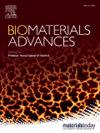Laminin expression profiles of osteogenic-and chondrogenic-induced dECM sheets
IF 5.5
2区 医学
Q2 MATERIALS SCIENCE, BIOMATERIALS
Materials Science & Engineering C-Materials for Biological Applications
Pub Date : 2024-11-30
DOI:10.1016/j.bioadv.2024.214127
引用次数: 0
Abstract
Decellularized extracellular matrix sheets (dECMSs) produced by stem cells have attracted attention because they preserve the natural biological activity of the ECM to direct lineage-specific differentiation with less immunogenicity. As a core ECM protein, laminin modulates cellular phenotype and differentiation. Nevertheless, no studies thus far have explored the distribution and abundance of laminins in diverse dECMSs. Herein, we first compared the differential expression of laminins among dECMSs in osteogenic-induced medium (OI-dECMS), chondrogenic-induced medium (CI-dECMS), and standard medium (dECMS), employing a defined mass spectrometry (MS)-based proteomic analysis. In vitro, dECMSs were verified to be successfully decellularized. Cluster analysis identified a marked fluctuation in the expression of 7 laminins and 17 laminin-associated proteins in OI-dECMS vs dECMS and CI-dECMS vs dECMS. Two significantly changed pathways were selected from the KEGG pathway enrichment analysis: the FAK/ERK pathway and the PI3K/AKT pathway.
Moreover, Alkaline Phosphatase (ALP) activity, Alcian blue staining, and RT-qPCR results for recellularization showed that CI-dECMS promotes chondrogenesis while OI-dECMS inhibits osteogenesis compared with dECMS. In vivo experiments were conducted to implant dECMSs in a rat osteochondral defect, demonstrating that dECMS and CI-dECMS promoted bone and cartilage repair. Furthermore, the inhibitory analysis was performed to verify the function of specific laminin isoforms modulating osteogenesis and chondrogenesis, which might be related to FAK/ERK and PI3K/AKT pathways. In summary, this study constructed dECMS, OI-dECMS, and CI-dECMS and uncovered the internal comprehensive molecular regulatory network centralized by laminins, thus proposing a biomimetic substitute for bone and cartilage regeneration.

成骨和软骨诱导的dECM薄片的层粘连蛋白表达谱。
由干细胞产生的脱细胞细胞外基质片(dECMSs)因其保留了ECM的天然生物活性而引起了人们的关注,以指导谱系特异性分化,而免疫原性较低。作为ECM的核心蛋白,层粘连蛋白调节细胞表型和分化。然而,到目前为止,还没有研究探讨层粘连蛋白在不同dECMSs中的分布和丰度。在本文中,我们首先比较了在成骨诱导培养基(OI-dECMS)、软骨诱导培养基(CI-dECMS)和标准培养基(dECMS)中dECMS中层粘胶蛋白的差异表达,采用了基于定义质谱(MS)的蛋白质组学分析。在体外,证实dECMSs成功脱细胞。聚类分析发现7个层粘连蛋白和17个层粘连蛋白相关蛋白的表达在i -dECMS和CI-dECMS中有明显的波动。从KEGG通路富集分析中选择了两个显著变化的通路:FAK/ERK通路和PI3K/AKT通路。此外,碱性磷酸酶(ALP)活性、阿利新蓝染色和细胞再化RT-qPCR结果显示,与dECMS相比,CI-dECMS促进软骨形成,而io -dECMS抑制骨形成。将dECMS植入大鼠骨软骨缺损的体内实验表明,dECMS和CI-dECMS促进骨软骨修复。此外,通过抑制分析验证了特定层粘连蛋白亚型调节成骨和软骨形成的功能,这可能与FAK/ERK和PI3K/AKT通路有关。综上所述,本研究构建了dECMS、OI-dECMS和CI-dECMS,揭示了内部以层合蛋白为中心的综合分子调控网络,提出了骨软骨再生的仿生替代品。
本文章由计算机程序翻译,如有差异,请以英文原文为准。
求助全文
约1分钟内获得全文
求助全文
来源期刊
CiteScore
17.80
自引率
0.00%
发文量
501
审稿时长
27 days
期刊介绍:
Biomaterials Advances, previously known as Materials Science and Engineering: C-Materials for Biological Applications (P-ISSN: 0928-4931, E-ISSN: 1873-0191). Includes topics at the interface of the biomedical sciences and materials engineering. These topics include:
• Bioinspired and biomimetic materials for medical applications
• Materials of biological origin for medical applications
• Materials for "active" medical applications
• Self-assembling and self-healing materials for medical applications
• "Smart" (i.e., stimulus-response) materials for medical applications
• Ceramic, metallic, polymeric, and composite materials for medical applications
• Materials for in vivo sensing
• Materials for in vivo imaging
• Materials for delivery of pharmacologic agents and vaccines
• Novel approaches for characterizing and modeling materials for medical applications
Manuscripts on biological topics without a materials science component, or manuscripts on materials science without biological applications, will not be considered for publication in Materials Science and Engineering C. New submissions are first assessed for language, scope and originality (plagiarism check) and can be desk rejected before review if they need English language improvements, are out of scope or present excessive duplication with published sources.
Biomaterials Advances sits within Elsevier''s biomaterials science portfolio alongside Biomaterials, Materials Today Bio and Biomaterials and Biosystems. As part of the broader Materials Today family, Biomaterials Advances offers authors rigorous peer review, rapid decisions, and high visibility. We look forward to receiving your submissions!

 求助内容:
求助内容: 应助结果提醒方式:
应助结果提醒方式:


